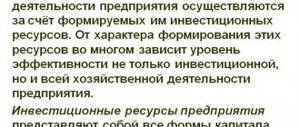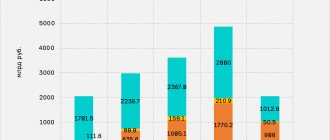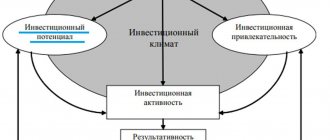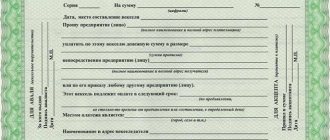Basic Concepts
From an accounting point of view, investment assets are fixed assets, property complexes, unfinished construction and intangible objects that require significant cash costs and a long time for commissioning.
In a more general sense, this concept consists of two: asset and investment. An asset is all the property of a company or, for example, a family. Investment is the process of achieving your goals. If this goal is money, then investment is an investment in assets that generate income. If it is to preserve accumulated capital, then investment will be the purchase of assets with a minimum level of risk. The investor's goal may be power or fame, then he will invest money in appropriate objects.
Do you need investments?
The purpose of investments is not as clear as it seems at first glance.
Investments can bring not only financial income, they can serve as a status factor, perform advertising functions and much more. Each option has its own tools. Many investors set capital preservation as their primary goal, considering profit a secondary investment factor. Based on the number of assets available to the population, one can get a general picture of economic literacy and living standards in the country.
For busy investors who do not want to spend time monitoring and analyzing the market, economic structures offer to use the services of funds. Also, mutual funds and ETFs are considered an excellent solution for novice investors who have just begun to comprehend the intricacies of market trading. Assets owned by the funds are managed by professional market participants, usually bank traders or employees of companies focused on investment activities.
Classification and types of investment assets
Investment assets are grouped according to a number of criteria. By investment objects there are:
- Material. Investments in fixed assets, unfinished construction. In this case, the investor invests money in real means of production, which create added value, which subsequently turns into profit.
- Financial. Purchase of financial instruments that do not have a real material form. They exist only in the form of entries in accounting accounts. The source of profit is the change in the price of the asset.
- Intelligent. Purchase, development, obtaining patents, licenses, copyrights.
- Research. Carrying out research and development work.
According to the purpose of investment, they are divided into:
- Direct. Investing in real business: production, trade, etc. The goal is the creation and development of core activities.
- Briefcases. Investment in financial instruments of the stock or foreign exchange market. The goal is to make a profit by increasing the value of the portfolio as a result of concluding purchase and sale transactions of financial instruments.
- Non-financial. Investments in intellectual property and copyright objects. The goal is to increase profits through the use of a recognizable brand, unique scientific developments, copyrights, etc.
By investment subject:
- Private. Investments of companies and individuals.
- State. Investment objects belong to the state.
- Foreign. Investments of non-resident legal entities and individuals.
- Mixed. Investment objects belong to several of the above groups. Most often encountered in the implementation of large-scale projects.
Depending on the direction of capital movement:
- Primary. Investment of funds at the stage of investment formation.
- Secondary. Investing the profits.
- Disinvestment. Withdrawal of funds from a project due to its futility or for the purpose of investing capital in alternative objects.
By liquidity level:
- Highly liquid. Investments in financial assets that can be easily sold on the market without significant loss in value.
- Medium liquid. Can be converted into cash within 1 year.
- Low liquidity. Complex large-scale production with a long payback period. This also includes some financial assets and intellectual property.
- Not liquid. Unprofitable production, financial assets that are not in demand.
By risk level:
- Risk-free. There are very few such assets. Any investment, even in the most profitable business, is a risk.
- Conservative. With a level of risk below the market or industry average.
- Moderate. With risk at the level of the average.
- Risky. The risk of capital loss is above average (read more: which assets are the riskiest).
As a rule, risk and return are directly related.
The higher the potential profit of the project, the higher the risk of losing capital. By date:
- short-term – capital return period up to 1 year;
- medium-term - from 1 to 3 years;
- long-term - over 3 years.
Geographically:
- domestic - investments in the economy of your country;
- external - investments in foreign projects.
By subject of management:
- active - the investor himself carries out operations with assets;
- passive - management is carried out by a third party.
Investment principles
If you want to start learning actual investing from scratch, be sure to thoroughly understand its basic principles:
- Unlike the growth of the national currency, real investments multiply several times faster .
- Compared to financial investments, these investments have higher returns and lower risks .
- Investments in real assets are an opportunity to provide an organization with intensive development, improve product quality, and help develop new markets.
- Real capital investments provide enterprises with a stable cash flow , which is achieved through depreciation charges, charged even if the project does not bring profit.
- Rapid technological progress exposes actual investments to obsolescence.
- Actual investments have low levels of liquidity .
Features of valuation and accounting of investment assets
In the balance sheet of an enterprise, all assets are reflected in the first section. The following accounts are intended for accounting for investment assets: 08 “Investments in non-current assets”, 58 “Financial investments”.
The company itself must establish in its accounting policies the criteria for classifying assets as investment assets. International Financial Reporting Standards (IFRS) do not contain clear concepts of “long time” and “significant expenses”. They will be individual for each enterprise.
According to the accounting rules (PBU), the book value of investment objects consists of:
- construction, development or acquisition costs;
- interest on loans aimed at investing in investment assets.
Interest on loans is included in the cost of the asset until it is put into operation, if it has already been purchased or work has begun on its construction (development) using borrowed funds. From the 1st day of the month following the month the facility was put into operation, interest on loans and borrowings is included in operating expenses.
Example. The company purchased equipment for the production of products worth RUB 1,180,000, including VAT - RUB 180,000. For this purpose, a loan agreement was drawn up for a period of 2 years at 12% per annum. The following entries will be reflected in the accounting records:
| date | Account Debit | Account Credit | Amount, rub. | comments |
| 15.08.2017 | 51 Funds in the current account | 67 Calculations for long-term loans and borrowings | 1 180 000 | Obtaining a bank loan |
| 15.08.2017 | 60 Settlements with suppliers and contractors | 51 Funds in the current account | 1 180 000 | Payment to the supplier |
| 15.08.2017 | 08 Investments in non-current assets | 60 Settlements with suppliers and contractors | 1 000 000 | Purchase of equipment |
| 15.08.2017 | 19 VAT on purchased assets | 60 Settlements with suppliers and contractors | 180 000 | Input VAT amount |
| 31.08.2017 | 08 Investments in non-current assets | 67 Calculations for long-term loans and borrowings | 6 207,12 | The amount of accrued interest for August is reflected |
| 02.09.2017 | 01 Fixed assets | 08 Investments in non-current assets | 1 006 207,12 | Commissioning of the facility |
If an enterprise has taken out a loan to purchase an investment asset, but for some reason temporarily does not use the funds for their intended purpose, it can invest this money in a financial asset: issue a loan or place it in a bank deposit account. Then the accrued interest on the loan can be reduced by the amount of profit received.
In addition, if construction (development) of an investment asset is suspended for more than 3 months, interest will be included in operating expenses starting from the 1st day of the month following the 3rd month of suspension of work. After their renewal, the enterprise has the right to again attribute interest to accounts for accounting for financial investments.
After putting a fixed asset into operation, its cost is gradually included in the price of finished products through depreciation. The exception is land plots and environmental management facilities, housing stock and other similar property, the properties of which do not change over time. If we are talking about a financial asset, it is on the company’s balance sheet until it is sold or redeemed.
We divide the budget correctly
You can take your entire salary every month and divide it into 50 envelopes. But most likely, after a month or two you will become furious with such a system and return to old habits. Therefore, we do not recommend doing this.
There are general principles for budget distribution that can be used as proposed or modified to suit your needs.
Crushing rule: 50/20/30
- 50% - use it to pay off your main expenses: food, taxes, housing and communal services;
- 20% - set aside and use it to pay off debts and loans;
- 30% will help you in pleasant spending on entertainment and pleasant little things.
This method can be called simple and effective. It does not burden you at all when planning and helps you build a money management strategy. Let's look at another option that will help you understand how to allocate money for investment.
Personal investments and family assets
You don't have to be the owner of your own company to invest. Every family has property: an apartment, a car, a dacha, free money. These are assets, which means they can be investment assets. There are several options for personal investment, let's look at them in more detail.
Bank deposit
The easiest way to invest money, which does not require experience or special knowledge. The investor can terminate the contract at any time and withdraw his money. The most he will lose is the accumulated interest. The rule here is: “The more reliable the bank, the lower the interest rate.” Rates are at the level of 4-6% per annum.
When making a bank deposit, it is better not to exceed the amount of 1.4 million rubles, which is insured in accordance with the deposit insurance system. Larger amounts can only be placed in very reliable banks.
Pros: high reliability and liquidity. Cons: low profitability.
Financial markets
These are stocks, bonds and their derivatives. You can invest yourself or transfer assets to trust management. To conduct his own operations, an investor must know what and when to buy, when to sell, be able to build a strategy, and limit risks.
If you don’t have this knowledge, it’s better to put the money in trust. In this case, all decisions are made by professionals who charge a fee for this. Profitability can reach 20-30% per annum, but the investor risks losing his capital just as easily.
Pros: high profitability. Cons: significant risk, high trustee commission.
Foreign currency
Investments in currency make sense only for those who have significant capital: from 100 thousand dollars. Otherwise, the profit will be insignificant, and a significant part of it will be spent on compensating for the difference between the purchase and sale rates of the currency.
For example, citizen A decided to buy 1 thousand dollars at 67 rubles. (market rate – 68). The exchange rate increased by 2 rubles and amounted to 70 rubles. But he can only sell his thousand for 69 rubles. The profit will be 2 thousand rubles. And this may take several months.
For private investors, it is more profitable to invest in the currency that accounts for the bulk of everyday expenses. It makes sense to buy foreign currency if you plan to spend money in it (for example, going on vacation).
Cons: high risk, low income.
Real estate
Investing in real estate is considered one of the most reliable areas of investment. This is stable: an apartment is an apartment. But there are also some difficulties. The property needs to be maintained, and this is an additional expense. Of course, you can rent it out, but you will have to spend your time on this: finding a tenant, monitoring the condition of the apartment. It is not uncommon for the rent to be unable to compensate for repairs needed after the tenant vacates the apartment. And it’s not easy to get rent.
Real estate should be considered as a tool for preserving capital. Prices for apartments and non-residential premises are almost always rising. Even after falling during periods of crisis, they recover over time. But you shouldn’t count on making money from rising prices. Firstly, this takes a lot of time, during which time the property will have to be maintained. Secondly, selling an apartment quickly is not always possible. And during periods of economic downturn, this is even more difficult.
Pros: reliability. Cons: low liquidity, insignificant income.
Precious metals
A private investor can purchase gold, silver or platinum bullion. Precious metals always increase in value over the long term. Additionally, anything that has a real physical form is considered the safest investment. But buying real precious metals is difficult because:
- In Russia, few companies offer such a service.
- Metal needs to be stored somewhere. The best option is a safe deposit box, for which you need to pay.
Another option is to open a bank account denominated in precious metal. At its core, it is the same as foreign currency. This option should be considered only if the investment amount is not thousands, but hundreds of thousands of rubles.
Pros: reliability. Disadvantages: large sums are required to invest.
How to make everything work out
It’s already a lot to start with, but if it’s uncomfortable to carry out the task, most likely you won’t be able to finish it. Try to plan a realistic budget that allows you to live comfortably. Don’t go too far if you allowed yourself everything before; at this stage, just stick to the principle of rationality, but don’t try to comprehend asceticism.
You have a plan and goals, remind yourself of them, try to visualize them. If you want to become an investor, start reading useful articles regularly. Make a list of books for self-education on this topic.
Try changing bad habits. For example, since you decide to spend wisely, give up fast food and eat healthy. Of course, this will significantly reduce costs. During the warmer months, you can often walk to the store or park instead of driving and refilling the tank. These little things will allow you to save money and understand how to allocate money for investments.
If you have loans, allocate money to the most unprofitable one and close it. It will be labor-intensive, but will bear fruit in the future.
Don't think that saving is fast. Getting ready to start saving can take some time. But then, following our tips, you can save enough money and invest it in investments.
To get motivated, take a look at the investment programs we offer. Each of them allows you to achieve what you want and receive additional income. Select yours to include in your list of medium-term goals.
Rule for creating a financial cushion
A simplified version of the previous system:
- 20% - we put it into savings and pay off debts;
- 80% - we spend it usefully and as our heart desires.
Now let's talk about the financial cushion, why do you think it is needed? In fact, this reserve is created with the aim of insuring oneself against problems in the event of: job loss, illness, divorce, moving and other everyday situations. When a person finds himself in a situation that is unusual for himself, he tends not to think about the consequences.
I have an irregular income, what should I do in this case?
Not everyone works on a salary, so one month can be successful and profitable, and another completely unsuccessful. If this is your job, then we have some tips. They can help you figure out how to allocate money for investments.
- Calculate your average income over the past few years and plan your budget based on these indicators.
- From your monthly income, determine a specific amount that will be considered a salary, and set aside the rest, so you can save up for your goals and create a financial cushion.
- Maintain a budget taking into account the profitability of the month; create two tables for this for successful and unsuccessful periods.











